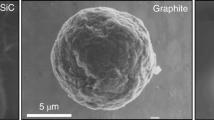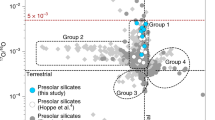Abstract
Primitive Solar System materials, such as certain types of meteorites, interplanetary dust particles and cometary matter, contain small quantities of refractory dust grains that are older than our Solar System. These ‘presolar grains’ condensed in the winds of evolved stars and in the ejecta of stellar explosions, and they were part of the interstellar gas and dust cloud from which our Solar System formed 4.57 billion years ago1. Interstellar dust is not only stardust but forms in the interstellar medium as well, predominantly as silicates, and, to a lesser extent, as carbonaceous dust and iron particles2. Presolar grains represent a sample of stardust, and their abundances in primitive Solar System materials can be used to constrain the fraction of stardust among interstellar dust. Here we show that the size distribution of presolar silicates follows that observationally derived for interstellar dust, at least in the diameter range 100–500 nm, that current estimates of presolar grain abundances (mass fractions) are at least a factor of 2 too low, and that several per cent of the interstellar dust in the interstellar cloud pre-dating our Solar System was stardust, making it a minor but still important ingredient of the starting material from which our Solar System formed.
This is a preview of subscription content, access via your institution
Access options
Access Nature and 54 other Nature Portfolio journals
Get Nature+, our best-value online-access subscription
$29.99 / 30 days
cancel any time
Subscribe to this journal
Receive 12 digital issues and online access to articles
$119.00 per year
only $9.92 per issue
Buy this article
- Purchase on Springer Link
- Instant access to full article PDF
Prices may be subject to local taxes which are calculated during checkout




Similar content being viewed by others
References
Zinner, E. in Meteorites and Cosmochemical Processes Vol. 1 (ed. Davis, A. M.) 181–213 (Elsevier, Amsterdam, 2014).
Zhukovska, S., Gail, H.-P. & Trieloff, M. Evolution of interstellar dust and stardust in the solar neighbourhood. Astron. Astrophys. 479, 453–480 (2008).
Floss, C. & Haenecour, P. Presolar silicate grains: abundances, isotopic and elemental compositions, and the effects of secondary processing. Geochem. J. 50, 3–15 (2016).
Messenger, S., Keller, L. P., Stadermann, F., Walker, R. M. & Zinner, E. Samples of stars beyond the Solar System: silicate grains in interplanetary dust. Science 300, 105–108 (2003).
Floss, C. et al. Identification of isotopically primitive interplanetary dust particles: a NanoSIMS isotopic imaging study. Geochim. Cosmochim. Acta 70, 2371–2399 (2006).
Busemann, H. et al. Ultra-primitive interplanetary dust particles from the comet 26P/Grigg–Skjellerup dust stream collection. Earth Planet. Sci. Lett. 288, 44–57 (2009).
McKeegan, K. D. et al. Isotopic compositions of cometary matter returned by Stardust. Science 314, 1724–1728 (2006).
Floss, C., Stadermann, F. J., Kearsley, A. T., Burchell, M. J. & Ong, W. J. The abundance of presolar grains in comet 81P/Wild 2. Astrophys. J. 763, 140 (2013).
Leitner, J., Heck, P. R., Hoppe, P. & Huth, J. The C-, N-, and O-isotopic composition of cometary dust from comet 81P/Wild 2. Lunar Planet. Sci. 43, 1839 (2012).
Hynes, K. M. & Gyngard, F. The presolar graindata base: http://presolar.wustl.edu/~pgd. Lunar Planet. Sci. 40, 1198 (2009).
Mathis, J. S., Rumpl, W. & Nordsieck, K. H. The size distribution of interstellar grains. Astrophys. J. 217, 425–433 (1977).
Floss, C. & Stadermann, F. Auger nanoprobe analysis of presolar ferromagnesian silicate grains from primitive CR chondrites QUE 99177 and MET 00426. Geochim. Cosmochim. Acta 73, 2415–2440 (2009).
Nguyen, A., Nittler, L. R., Stadermann, F., Stroud, R. & Alexander, C. M. O. D. Coordinated analyses of presolar grains in the Allan Hills 77307 and Queen Elizabeth Range 99177 meteorites. Astrophys. J. 719, 166–189 (2010).
Vollmer, C., Hoppe, P., Stadermann, F. J., Floss, C. & Brenker, F. NanoSIMS analysis and Auger electron spectroscopy of silicate and oxide stardust from the carbonaceous chondrite Acfer 094. Geochim. Cosmochim. Acta 73, 7127–7149 (2009).
Hoppe, P., Leitner, J. & Kodolányi, J. New constraints on the abundances of silicate and oxide stardust from supernovae in the Acfer 094 meteorite. Astrophys. J. 808, L9 (2015).
Leitner, J., Vollmer, C., Floss, C., Zipfel, J. & Hoppe, P. Ancient stardust in fine-grained chondrule dust rims from carbonaceous chondrites. Earth Planet. Sci. Lett. 434, 117–128 (2016).
Nittler, L. R., Alexander, C. M. O. D., Gao, X., Walker, R. M. & Zinner, E. Stellar sapphires: the properties and origins of presolar Al2O3 in meteorites. Astrophys. J. 483, 475–495 (1997).
Nittler, L. R. On the mass and metallicity distributions of the parent AGB stars of O-rich presolar dust. Publ. Astron. Soc. Aust. 26, 271–277 (2009).
Nittler, L. R. et al. Aluminum-, calcium- and titanium-rich oxide stardust in ordinary chondrite meteorites. Astrophys. J. 682, 1450–1478 (2008).
Kodolányi, J., Hoppe, P., Gröner, E., Pauly, C. & Mücklich, F. The Mg isotope composition of presolar silicate grains from red giant stars. Geochim. Cosmochim. Acta 140, 577–605 (2014).
Nguyen, A. N. et al. Characterization of presolar silicate and oxide grains in primitive carbonaceous chondrites. Astrophys. J. 656, 1223–1240 (2007).
Weingartner, J. C. & Draine, B. T. Dust grain-size distributions and extinction in the Milky Way, Large Magellanic Cloud, and Small Magellanic Cloud. Astrophys. J. 548, 296 (2001).
Gail, H.-P. & Hoppe, P. in Protoplanetary Dust (eds Apai, D. & Lauretta, D. S.) 27–65 (Cambridge Univ. Press, 2010).
Brownlee, D. et al. Comet 81P/Wild 2 under a microscope. Science 314, 1711–1716 (2006).
Ishii, H. A. et al. Comparison of comet 81P/Wild 2 dust with interplanetary dust from comets. Science 319, 447 (2008).
Keller, L. P. & Messenger, S. On the origins of GEMS grains. Geochim. Cosmochim. Acta 75, 5336–5365 (2011).
Draine, B. T. & Salpeter, E. E. Destruction mechanisms for interstellar dust. Astrophys. J. 231, 438–455 (1979).
Jones, A. P., Tielens, A. G. G. M., Hollenbach, D. J. & McKee, C. F. Grain destruction in shocks in the interstellar medium. Astrophys. J. 433, 797–810 (1994).
Heck, P. et al. Interstellar residence times of presolar SiC dust grains from the Murchison carbonaceous meteorite. Astrophys. J. 698, 1155 (2009).
Zhukovska, S., Dobbs, C., Jenkins, E. B. & Klessen, R. S. Modeling dust evolution in galaxies with a multiphase, inhomogeneous ISM. Astrophys. J. 831, 147 (2016).
Hoppe, P., Cohen, S. & Meibom, A. NanoSIMS: technical aspects and applications in cosmochemistry and biological geochemistry. Geostand. Geoanal. Res. 37, 111–154 (2013).
Slodzian, G., Chaintreau, M., Dennebouy, R. & Rousse, A. Precise in-situ measurements of isotopic abundances with pulse counting of sputtered ions. Eur. Phys. J. Appl. Phys. 14, 199–231 (2001).
Acknowledgements
We thank E. Gröner and A. Sorowka for technical support, the Natural History Museum in Vienna for the loan of the Acfer 094 sample, and ANSMET for the loan of the QUE 99177 and MET 00426 samples. US Antarctic meteorite samples are recovered by the Antarctic Search for Meteorites (ANSMET) program funded by the National Science Foundation and NASA, and characterized and curated by the Department of Mineral Sciences of the Smithsonian Institution and Astromaterials Curation Office at NASA Johnson Space Center. This work was supported by the Max Planck Society and the Deutsche Forschungsgemeinschaft (grant LE3279/1-1 to J.L.).
Author information
Authors and Affiliations
Contributions
P.H. conducted the NanoSIMS work and J.L. the scanning electron microscope work. P.H. wrote most of the paper with important input from J.K. and J.L.
Corresponding author
Ethics declarations
Competing interests
The authors declare no competing financial interests.
Additional information
Publisher’s note: Springer Nature remains neutral with regard to jurisdictional claims in published maps and institutional affiliations.
Electronic supplementary material
Supplementary Information
Supplementary Figures 1–2 and Supplementary Table 1
Rights and permissions
About this article
Cite this article
Hoppe, P., Leitner, J. & Kodolányi, J. The stardust abundance in the local interstellar cloud at the birth of the Solar System. Nat Astron 1, 617–620 (2017). https://doi.org/10.1038/s41550-017-0215-0
Received:
Accepted:
Published:
Issue Date:
DOI: https://doi.org/10.1038/s41550-017-0215-0
This article is cited by
-
A Comparison of Presolar Isotopic Signatures in Laboratory-Studied Primitive Solar System Materials and Comet 67P/Churyumov-Gerasimenko: New Insights from Light Elements, Halogens, and Noble Gases
Space Science Reviews (2023)
-
Dust from supernovae and their progenitors in the solar nebula
Nature Astronomy (2022)
-
Sample return of primitive matter from the outer Solar System
Experimental Astronomy (2022)
-
Analytical protocols for Phobos regolith samples returned by the Martian Moons eXploration (MMX) mission
Earth, Planets and Space (2021)
-
Accretion of the Earth—Missing Components?
Space Science Reviews (2020)



